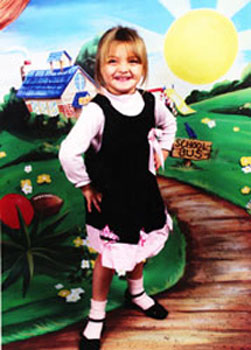Samantha Overcomes Brachial Plexus Injury, Looks Forward to College
When she was only two years old, Samantha and her family were involved in a motor vehicle collision. After being in a coma for three weeks, Samantha woke up suffering from multiple injuries, including a paralyzed arm due to a traumatic brachial plexus injury. After undergoing surgery, Samantha enjoyed swimming, dancing, and cheerleading. Today, Samantha has been accepted to attend Wright State University and, according to her grandmother, is "truly blessed to overcome her health issues."
A Life-Changing Moment
Samantha Baker's life changed forever when she and her family were involved in a serious motor vehicle collision. Samantha, only two years old at the time, laid unconscious in a hospital bed at Dayton Children's Hospital. Three weeks passed before she woke up. Samantha had multiple injuries, which required many interventions, including a neck brace, feeding tube and tracheostomy tube.
Four weeks after the accident, Samantha was unable to move or lift her right arm. Her physician recognized symptoms of a traumatic brachial plexus injury and suggested that the family visit the Brachial Plexus Center at Cincinnati Children's to be examined by a team of specialists.
Traumatic brachial plexus injuries can occur as the result of motor vehicle, sports, bike or ATV accidents. The brachial plexus is a network of nerves that conducts signals from the central nervous system to the shoulder, arm and hand. Some of Samantha's brachial plexus nerves had avulsed, which means they completely separated from the spinal cord. Avulsion, the most severe type of nerve injury, can result in absence of movement, sensation and / or function in the affected arm and hand.
"Samantha's arm was completely paralyzed," said Cindy, Samantha's grandmother and legal guardian. "She had no movement, her arm had dislocated at her shoulder and just hung there. It was totally useless to her."
Samantha Undergoes Nerve Transfer Surgery
Samantha underwent nerve transfer surgery, including transfer of healthy nerves to replace the damaged ones to help generate re-growth.
"The staff went out of their way to make Samantha feel comfortable and unafraid," said Cindy. "They read her stories and talked to her before she fell asleep for the surgery."
Nerves grow at a rate of one inch per month, so it can take several years before the nerves fully regenerate. Once regenerated, the nerves start sending signals to the muscles, which must occur in order to gain movement. Samantha began to move her arm just seven months after the surgery.
In order to build strength and flexibility in her arm, Samantha started occupational therapy one and a half weeks after surgery, which continued for several months decreasing in frequency as she continued to improve.
A "Miracle Girl"
Cindy has been amazed at her granddaughter's recovery. "Samantha is my miracle girl," she said. "She's come a long way. You would never know by looking at her today all that she has been through." The only noticeable sign of her brachial plexus injury is a scar, which is covered by her clothes. Otherwise, Cindy says other children do not know that Samantha ever had a problem with her arm.
Before surgery, she had absolutely no movement in her arm. Now Samantha can perform important everyday tasks, such as getting dressed and feeding herself. It has also given her more opportunities to experience the world around her. Samantha likes to dance, cheerlead and swim -- all activities she could not do before her surgery. "Now she can do almost anything she wants," said Cindy.
Samantha's greatest struggle has been coping emotionally with the tragedy and pain from the car accident. Her sister, Kathy, helped her get through the physical and emotional challenges. The family says the most positive outcome since the injury has been Samantha's regaining full use of her arm.
(Updated: December 2018)





